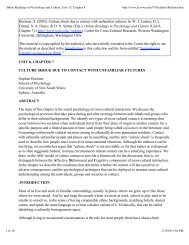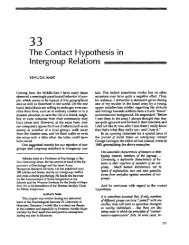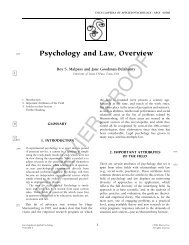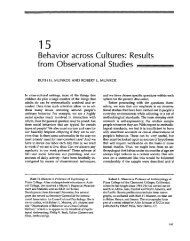From the Lab to the Police Station - Eyewitness Identification Lab ...
From the Lab to the Police Station - Eyewitness Identification Lab ...
From the Lab to the Police Station - Eyewitness Identification Lab ...
Create successful ePaper yourself
Turn your PDF publications into a flip-book with our unique Google optimized e-Paper software.
dom, South Africa, Germany, and Australia, making this<br />
one of <strong>the</strong> most replicated effects in <strong>the</strong> eyewitness area.<br />
The simplicity and robustness of <strong>the</strong> sequential-superiority<br />
effect has made it one of <strong>the</strong> most important of all <strong>the</strong><br />
practical contributions of eyewitness system-variable<br />
research.<br />
John W.<br />
Turtle<br />
might not be in <strong>the</strong> lineup helps reduce <strong>the</strong> tendency <strong>to</strong><br />
simply pick <strong>the</strong> person who (relative <strong>to</strong> <strong>the</strong> o<strong>the</strong>r lineup<br />
members) looks most like <strong>the</strong> perpetra<strong>to</strong>r, but it does not<br />
eliminate <strong>the</strong> tendency al<strong>to</strong>ge<strong>the</strong>r.<br />
R. C. L. Lindsay and Wells (1985) used <strong>the</strong> relative<br />
judgment conceptualization <strong>to</strong> devise an alternative presentation<br />
procedure that would reduce <strong>the</strong> tendency of eyewitnesses<br />
<strong>to</strong> rely on relative judgments, namely, a sequential<br />
presentation. In <strong>the</strong> sequential procedure, <strong>the</strong> eyewitness is<br />
presented with one lineup member at a time, and <strong>the</strong><br />
eyewitness must decide for each person whe<strong>the</strong>r that person<br />
is <strong>the</strong> perpetra<strong>to</strong>r prior <strong>to</strong> being allowed <strong>to</strong> view <strong>the</strong><br />
next person. This one-at-a-time procedure discourages <strong>the</strong><br />
eyewitness from simply deciding who looks most like <strong>the</strong><br />
perpetra<strong>to</strong>r. Although <strong>the</strong> eyewitness could decide that <strong>the</strong><br />
person being viewed currently looks more like <strong>the</strong> perpetra<strong>to</strong>r<br />
than did <strong>the</strong> previous person, <strong>the</strong> eyewitness cannot<br />
be sure that <strong>the</strong> next (not yet viewed) person does not look<br />
even more like <strong>the</strong> perpetra<strong>to</strong>r than <strong>the</strong> one being viewed<br />
currently. Lindsay and Wells reasoned that this would force<br />
eyewitnesses <strong>to</strong> use a more absolute criterion (i.e., "Is this<br />
<strong>the</strong> perpetra<strong>to</strong>r or not?") ra<strong>the</strong>r than <strong>the</strong> relative-judgment<br />
criterion (i.e., "Is this person more similar <strong>to</strong> <strong>the</strong> perpetra<strong>to</strong>r<br />
than <strong>the</strong> o<strong>the</strong>r lineup members?"). Their data showed that<br />
<strong>the</strong> simultaneous and sequential procedures produced<br />
nearly identical correct identification rates when <strong>the</strong> perpetra<strong>to</strong>r<br />
was present in <strong>the</strong> lineup. When <strong>the</strong> lineup did not<br />
contain <strong>the</strong> perpetra<strong>to</strong>r, however, <strong>the</strong> rate of mistaken identifications<br />
was 43% with <strong>the</strong> simultaneous procedure and<br />
only 17% with <strong>the</strong> sequential. O<strong>the</strong>r studies have shown<br />
that <strong>the</strong> sequential procedure is also less sensitive <strong>to</strong> lineup<br />
biases (R. C. L. Lindsay, Lea, Nosworthy, et al., 1991). The<br />
sequential-superiority effect has been replicated in experiments<br />
across <strong>the</strong> United States, Canada, <strong>the</strong> United King-<br />
Confidence Malleability<br />
Considerable research effort over <strong>the</strong> past 20 years has<br />
been devoted <strong>to</strong> assessing <strong>the</strong> relation between eyewitness<br />
identification accuracy and <strong>the</strong> confidence or certainty of<br />
<strong>the</strong> eyewitness. This is an important issue because (a)<br />
people (including jurors) assume that a confident witness is<br />
an accurate witness (e.g., Wells, Lindsay, & Ferguson,<br />
1979), and (b) <strong>the</strong> judicial system has explicitly endorsed<br />
<strong>the</strong> idea that <strong>the</strong> certainty an eyewitness has in <strong>the</strong> identification<br />
is an indication of <strong>the</strong> accuracy of <strong>the</strong> identification<br />
(Neil v. Biggers, 1972).<br />
Research on eyewitness confidence has taught psychologists<br />
that <strong>the</strong> correlation between confidence and eyewitness<br />
identification accuracy is not a single value but<br />
ra<strong>the</strong>r is something that fluctuates as a function of several<br />
modera<strong>to</strong>rs. Meta-analyses indicate that <strong>the</strong> overall correlation<br />
across studies is approximately .29, but <strong>the</strong> estimated<br />
correlation rises and falls as a function of such things as<br />
viewing conditions and whe<strong>the</strong>r <strong>the</strong> analysis includes nonidentifying<br />
witnesses (see Sporer, Penrod, Read, & Cutler,<br />
1995). Leippe (1980) described a process by which eyewitness<br />
accuracy is a function of memory variables,<br />
whereas confidence is a function of social variables,<br />
<strong>the</strong>reby leading <strong>to</strong> <strong>the</strong> possibility of <strong>the</strong>ir dissociation under<br />
some conditions.<br />
In line with this idea, recent empirical evidence shows<br />
that <strong>the</strong> confidence of an eyewitness is malleable as a<br />
function of a system variable, namely, feedback, in a way<br />
that is independent of accuracy. <strong>Eyewitness</strong>es who make a<br />
mistaken identification but are <strong>the</strong>n <strong>to</strong>ld that a cowitness<br />
identified <strong>the</strong> same person or that <strong>the</strong> person identified is<br />
<strong>the</strong> actual suspect undergo confidence inflation (Luus &<br />
Wells, 1994; Wells & Bradfield, 1998, 1999). In o<strong>the</strong>r<br />
words, <strong>the</strong> justice system can induce false confidence in an<br />
eyewitness by giving feedback about <strong>the</strong> identification after<br />
<strong>the</strong> eyewitness has made a selection from <strong>the</strong> lineup. Giving<br />
feedback confirming an eyewitness's choice is a common<br />
practice in many police departments. When police<br />
investiga<strong>to</strong>rs confirm eyewitnesses' choices prior <strong>to</strong> assessing<br />
<strong>the</strong>ir confidence, <strong>the</strong> meaning of confidence becomes<br />
dis<strong>to</strong>rted. Ra<strong>the</strong>r than an indication of accuracy, high confidence<br />
could simply be an indication of feedback. Similarly,<br />
<strong>the</strong> recent work of Shaw and his colleagues indicates<br />
that repeated questioning of eyewitnesses can produce confidence<br />
inflation without increases in accuracy (Shaw,<br />
1996; Shaw, Garven, & Wood, 1997). Evidence suggests as<br />
well that directing eyewitnesses' attention <strong>to</strong> <strong>the</strong>ir decision<br />
processes might actually lower <strong>the</strong> confidence-accuracy<br />
relation (Robinson & Johnson, 1998).<br />
586 June 2000 • American Psychologist







